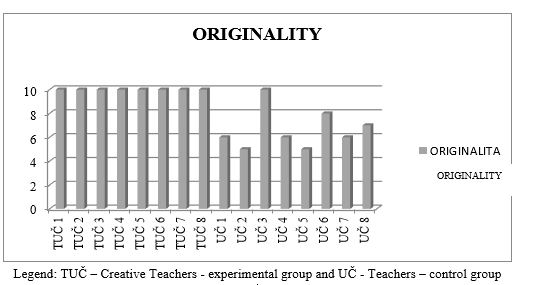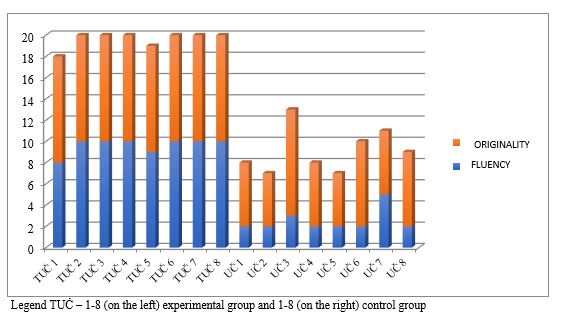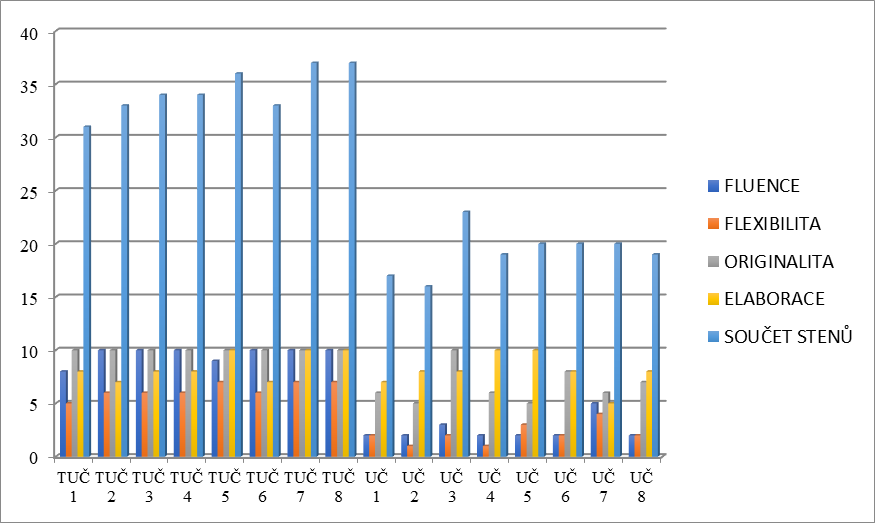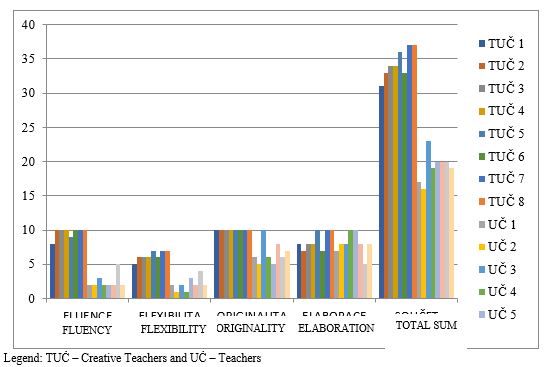Abstract
This paper surveys the standard of teachers’ creativity in kindergartens and compares results of creativity of selected groups. The goal of the research is to identify the standard of creative thinking of kindergarten teachers, who apply methods of creative drama in education and to compare it with educators who do not use creative drama in education. A qualitative comparative survey using the Torrance Test of Creative Thinking for kindergarten teachers was used. Obtained data from the measurement was processed with the help of descriptive methods and correlations and compared with experimental and control groups of teachers. The findings showed significant differences in kindergarten teachers’ development of creativity based on the creative thinking test where higher results were displayed by the experimental group in comparison to the control group. This comparison generates possibilities of further education of preschool educators in creativity and can positively influence education of kindergarten teachers in creative disciplines and increase creative education. It will also contribute to appreciation of creative drama for development of creativity of teachers.
Keywords: Creativitypre-school teacherkindergartencreativity test
Introduction
A creative preschool teacher will want to work with children in a creative way. Everyone has creative capabilities which can be developed into adulthood. One expectation of pre-school education is that teachers have developed creative capacities and encourages them to apply creative methods in order to support development of children’s creative thinking. Therefore, creative methods in education and methods of active learning are being used in creative drama form, which is a system of personal and social development and contains methods and techniques endorsing creativity development. Zelinová (2004) contends that “social-psychological trainings as a significant part of creative-humanistic education should become an educational component and should become an organic part of lifelong teachers’ education.” (p. 112)
Kindergarten teachers
Kindergarten teachers are expected to have sufficient knowledge about preschool age children, understand developmental peculiarities, able to respond to their needs and contrive to create suitable conditions for pedagogical work. They need to focus their entire work on the complex development of children. They can choose appropriate methods and forms of work, according to children´s age and their specific needs (Průcha & Koťátková, 2013). Thus, a great deal of responsibility is on teachers’ shoulders, both children’s safety and their development within the institution. Therefore, a great emphasis is put on the teacher´s professional competence. Průcha and Koťátková (2013) state that “professional competence is understood as a complex ability to perform teacher profession in success. It covers knowledge, skills and creativity, which teacher uses in order to educate children, ability to perceive and assess children´s needs, support them in individual development and to attract them for cognition and learning”. (p.56)
A teacher thus has to employ natural approaches, accept the values and rules of the society he/she is working in. In terms of his/her behaviour, s/he is a role model for children. Professional competences refer to a set of all the above mentioned teacher competences.
Creativity of preschool teachers and creativity measurement
Creativity of preschool teachers is perceived as a condition for the teacher´s discharge of responsibilities in a kindergarten and preschool education is based on employing creative pedagogical influence on children. According to Fichnová and Szobiová (2007) “creativity is an ability to create new, unusual and original ways of solution” (p. 5). In the past, an opinion prevailed that only artists, men of letters and scientists are gifted with creativity. Current findings point out the fact, that everyone is creative, differences are found only on its level, which is more creative or less. Zelina (1996) evidences, that creativity could be manifested in every activity, not just in scientific, artistic or technical creativity. However, creativity can be found in other areas, simply in every activity. Creativity can be developed in every single person, within school conditions, in every specific activity. According to Gubricová (2015) is creative the drama through the diversity and diversity of its methods provides the pupil with many stimuli for development creativity.
New approaches towards issues of creativity, mainly to its humanistic understanding, also admit a possibility, that a new and useful product is not always the result of creative activity. Basically, it is an expertise raised during creative activities, which enhances children and teachers through its new and valuable emotional experiences. Thus, experiences could be regarded as a product of creative activity (Hornáčková, Kottasová, Váňová and Jungrová, 2017).
Pecina (2008) lists programmes for creativity development, such as the Purdue creative thinking program, a productive thinking program, Torrance and Guilford programs, Williams’ program and many others. Creative activity has a great importance for development of cognitive abilities, the powers of intellect, and generally a versatile personality development. A creative personality is characterised by its features such as fluency, flexibility, originality, elaboration, sensitivity and improvisation, which can be measured.
Creativity can be measured by creativity tests using the same principles, divergent tasks, brainstorming, problem solving, a word exercise, figural, creativity movement, heuristic questions, and so on. The Torrance test of creative thinking, a very popular test, has been applied on children of preschool age, and has been extensively used in previous research; hence, this test was used for kindergarten teachers to identify their creativity development.
Problem Statement
Development of creativity of teachers is not sufficiently initiated; therefore it deserves more attention through research efforts, which would endorse its importance in terms of creative drama in education in preschool education.
This study investigated kindergarten teachers who are creative and apply creative drama in education in comparison to those who do not apply creative drama in education in their pedagogical practice.
Research Questions
The following research questions were initiated:
Are there differences in the creativity standards of kindergarten teachers who use creative drama in education and those who do not?
Is there a difference in the standard of creativity between kindergarten teachers who use creative drama in education and those who do not based on a test of creativity?
Research Methods
The research design was conceived as a qualitative-quantitative study. The research aim is to determine creative thinking of teachers in kindergartens, who apply creative drama in education and to compare it with teachers who do not use these methods.
The Torrance standardized test of creative thinking was used in the research which assessed factors such as fluency, flexibility, originality and elaboration for the demonstration of creativity values. Factors have been assessed in the field of:
Fluency is an ability to quickly create as many words, ideas, pictures, symbols that increase the probability of finding an optimal result. In the test of creative thinking, this was assessed by the ability to create as many pictures in individual tasks.
Flexibility or resiliency is an ability of changes, adaptability, variety of ideas and layouts.
Originality is the ability to come up with original and unique solutions.
Elaboration is an ability to create details, in order to complete a whole unit or a plan. It can be also an ability to form thoughts accurately.
Research sample
The research sample consisted of 80 kindergarten teachers who were divided into two groups; one which applied creative drama in education (an experimental group) and another group which did not apply creative drama in education (a control group). The selection of respondents was done according to the results from the questionnaire survey implemented on this sample in the previous year, which was focused on finding out whether teachers do apply drama education in kindergartens (Hornáčková, 2016).
The assessment was done according to a methodological manual and results were statistically processed. A comparison of results was made within a pilot study with 20 respondents, in order to show, whether there is difference at teachers who apply or do not apply drama in education in kindergartens.
Findings
Significant differences in originality were noted between experimental and control groups (Figure

Figure

Figure

Figure

Figure
The results clearly show that those kindergartens teachers who do apply creative drama with kindergarten children, demonstrate higher creativity values compared to those who do not.
Conclusion
Even though these are just initial results based on a preliminary study of two groups of kindergarten teachers – an experimental and a control group of teachers, the presented research focused on a comparison of creative thinking of kindergarten teachers has produced very important results. At kindergarten, teachers who apply were seen to have more highly developed creative thinking compared to teachers who did not.
This allows us to conclude that development of creativity of kindergarten teachers deserves greater attention and appreciation from policy makers and curriculum developers. A greater attention paid to the development of creativity of kindergarten teachers will result in more positive learning outcomes for the children, which is the ultimate aim of education at all levels.
This research has established that teachers who apply creative methods of teaching are highly creative in nature which is a great asset for any teacher who wishes to enhance the learning experiences of their pupils.
Acknowledgments
This paper was supported by the Specific Research of the Faculty of Education of the University of Hradec Králové 2018, number 2105, entitled: Creativity of Preschool Teachers.
References
- Gubricová, J. (2015). Potenciál metód tvorivej dramatiky pri rozvoji tvorivosti žiakov. In: J. Hanuliaková, D. Porubčanová (Eds.). Kuchárska kniha pre život alebo Cesty k edukácii pre život. Dubnica nad Váhom: Dubnický technologický inštitút v Dubnici nad Váhom.
- Hornáčková, V., Kottasová, J., Váňová, Z., & Jungrová, A. (2016). The Use of Methods and Techniques of Drama Education with Kindergarten Teachers. In: International journal of environmental, ecological, geomatics, earth science and engineering. 2905-2910. Connecticut: WASET.
- FichováI, K. & Szobiová, E. (2007). Rozvoj tvořivosti a klíčových kompetencí dětí. Praha: Portál.
- Lokšová, I. & Lokša, J. (1999). Pozornost, motivace, relaxace a tvořivost dětí ve škole. Praha: Portál.
- Pecina, P. (2008). Tvořivost ve vzdělávání žáků. Brno: Masarykova univerzita.
- Průcha, J. & Koťátková, S. (2013). Předškolní pedagogika. Praha: Portál.
- Zelina, M. (1996). Stratégie a metódy rozvoja osobnosti dieťaťa: metódy výchovy. Bratislava: Iris.
- Zelinová, M. (2004). Výchova človeka pre nové milénium: teória a prax tvorivo-humanistickej výchovy. Bratislava: Rokus.
Copyright information

This work is licensed under a Creative Commons Attribution-NonCommercial-NoDerivatives 4.0 International License.
About this article
Publication Date
14 January 2019
Article Doi
eBook ISBN
978-1-80296-052-5
Publisher
Future Academy
Volume
53
Print ISBN (optional)
-
Edition Number
1st Edition
Pages
1-812
Subjects
Education, educational psychology, counselling psychology
Cite this article as:
Hornáčková, V., Fischerová, E., Konečná, D., & Fendrychová, T. (2019). Creativity Development Of Kindergarten Teachers. In Z. Bekirogullari, M. Y. Minas, & R. X. Thambusamy (Eds.), ICEEPSY 2018: Education and Educational Psychology, vol 53. European Proceedings of Social and Behavioural Sciences (pp. 672-677). Future Academy. https://doi.org/10.15405/epsbs.2019.01.65

